by Editor | Nov 26, 2012 | Restaurants
Article and photos by Elena del Valle
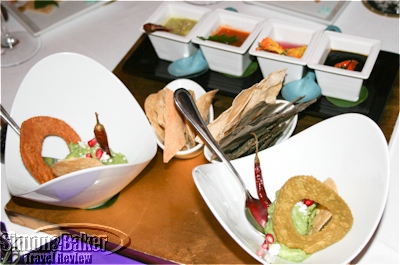
Nationalistic Guacamole with Requeson and Pomegranate
During a recent trip to Mexico City I attended a four-course dinner at Dulce Patria (Anatole France 100, Col. Polanco, 11560, Mexico City, Mexico, +52 55 33 00 39 99, fax +52 55 33 00 39 95, mortiz@dulcepatriamexico.com), a restaurant serving Updated Mexican Cuisine from Chef Martha Ortiz. The interior of the restaurant was colorful and there was a festive ambiance. Staff were attentive and the dishes were presented artistically on the plates. I would recommend this restaurant to friends who like spicy culinary experiences and a loud ambiance.
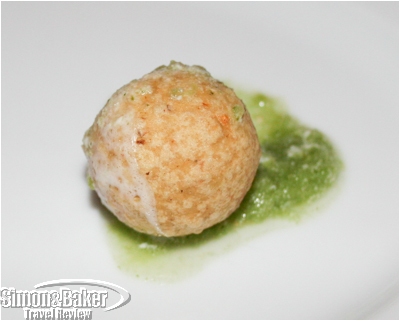
Game of Pork Crackling Marbles with Green Raw Salsa
The popular restaurant, with capacity for eighty guests, appeared sold out the Friday night of our dinner. The sound level was so loud I could barely hear my neighbors at the table or the servers when they approached me to take my order. By the time we left my throat was sore and I was slightly hoarse.
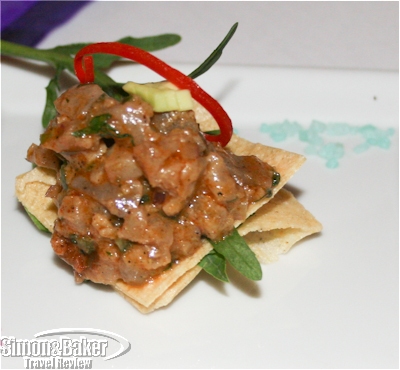
Corn Kite with Tuna and the Spirit of Habanero
I loved the tequila aperitif drinks. There were two kinds, tamarind and rose. While I liked both the delicate rose flavored version with a rose bud floating on top, the house specialty I learned later, was my favorite. Roses with margarita or Margarita Rose was made with Castilla rose essence, good quality tequila, a pinch of salt and lemon sorbet and decorated with rose petals.
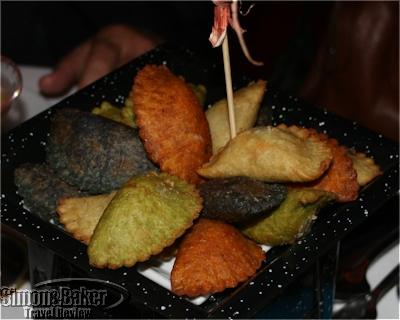
Multicoloured Quesadillas with Salsa Sultana pre-appetizers
To accompany our drinks the staff brought four types of appetizers: Nationalistic Guacamole with Requeson and Pomegranate (Guacamole nacionalista), Corn Kite with Tuna and the Spirit of Habanero (Papalotes de maiz y atun con espiritu de habanero), Game of Pork Crackling Marbles with Green Raw Salsa (Juego de canicas de chicharron con salsa verde cruda) and Multicoloured Quesadillas with Salsa Sultana (Quesadillas multicolores con salsa sultana).
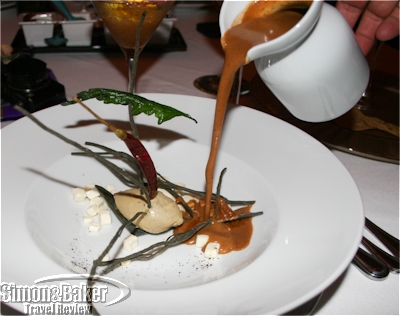
My black bean with foie gras appetizer
We had two choices each for the first and main courses. The server recommended the Velvety Black Bean Soup with Foie Gras and Dark Tortillas (Sopa cremosa de frijol negro con foie gras y tortillas oscuras) and The Chile en Nogada Jewel (La joya de chile en nogada).

Desserts, like this sorbet, were shared
Desserts, shared by the table, were Sólo sale de noche Belle de Nuit, Warm cacao and maize cake with colourful dragées and decorated animal cookies, Cornbread in a mystical chamomile flower sauce with caramel aureole, Fiesta of ice cream and sorbets of national flavour Soursop. There was also Hibiscus Jello (Gelatina de guanabana e hibiscus) and Pan de Lote. There were three sorbet flavors: spicy mango, lemon coriander, and tuna mezcal. Coffee and candy were served after dessert. The candy came in a pretty tray with tiny decorative airplanes hanging from a central pole.
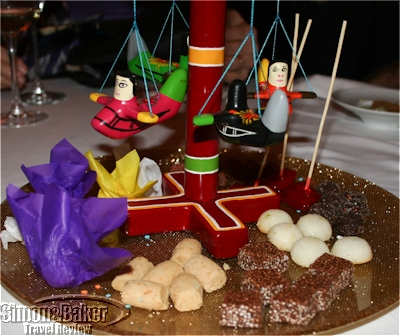
Post meal sweets arrived in a pretty carousel display
by Editor | Nov 19, 2012 | Luxury Travel

Costas Christ, chairman, international team of judges WTTC
Each year the World Travel & Tourism Council* (WTTC) recognizes innovative pioneers in sustainable tourism, following a three-step judging process including on-site evaluations of all finalists. The Council selected a panel meant to reflect all areas of the global Travel and Tourism industry including the private sector, academic institutions, non-profit organizations and government. This year the chairman of the international team of judges will be Costas Christ.
As part of the process the judges are expected to select a shortlist of 12 finalists by January 21, 2013. During the second stage of the process they will visit the properties and destinations for on-site evaluations.

Tony Charters, principal, Tony Charters & Associates

Gail Henry, sustainable tourism product specialist, Caribbean Tourism Organization

Clara Ines Sanchez Arciniegas, vice minister, Colombia

Mahen Sanghrajka, chief and founder, Big Five Tours & Expeditions

Pegi Vail, professor, Colombia University

Jalsa Urubshurow, CEO, Nomadic Expeditions and Three Camel Lodge
Following the on-site evaluations, the finalists are scheduled to progress into the last stage of the judging process. A separate Winner Selection Committee is expected to meet after a detailed review of the finalist judges’ recommendations, the award applications, and the on-site evaluation report, selecting one winner in each Award category. Organization representatives should announced the winners during the awards ceremony of the WTTC Global Summit on April 9, 2013 in Abu Dhabi, United Arab Emirates. Applications for the award are due by 26 November 2012.

Marilu Hernandez, president, Fundacion Haciendas del Mundo Maya

Judy Kepher-Gona, executive director, Base Camp Foundation
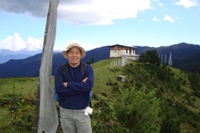
Karma Tshering, chief, Nature Recreation and Ecotourism, Department of Forests and Park Services, Bhutan

Mandip Singh Soin FRGS, managing director, Ibex Expeditions (PVT) Ltd

Graham Miller, head, School of Hospitality and Tourism Management, University of Surrey
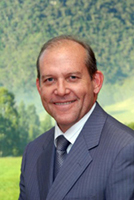
Tony Williams, director, Hospitality Operations, Qatar Foundation
This year’s judges are Clara Ines Sanchez Arciniegas, vice minister, Sustainable Tourism Development, Ministry of Commerce, Industry and Tourism, Colombia; Gail Henry, sustainable tourism product specialist, Caribbean Tourism Organization, Barbados; Graham Miller, head, School of Hospitality and Tourism Management, University of Surrey, United Kingdom; Jalsa Urubshurow, chief executive officer, Nomadic Expeditions and Three Camel Lodge, Mongolia; Judy Kepher-Gona, executive director, Base Camp Foundation, Kenya; Karma Tshering, chief, Nature Recreation and Ecotourism, Department of Forests and Park Services, Bhutan; Mahen Sanghrajka, chief and founder, Big Five Tours & Expeditions, United States and Kenya; Mandip Singh Soin, founder and managing director, Ibex Expeditions (PVT) Ltd, India; Marilu Hernandez, president, Fundacion Haciendas del Mundo Maya, Mexico; Pegi Vail, professor and sustainable tourism documentary film maker, Colombia University, United States; Tony Charters, principal, Tony Charters & Associates, Australia; and Tony Williams, director, Hospitality Operations, Qatar Foundation, Dubai.
The World Travel & Tourism Council (WTTC), a forum for business leaders in the travel and tourism industry, strives to raise awareness of travel and tourism as one of the world’s largest industries, supporting 255 million jobs and generating 9 per cent of world GDP. The Simon & Baker Travel Review is a Media Sponsor of the WTTC Tourism for Tomorrow 2013 Awards.
*Photos courtesy of World Travel & Tourism Council
by Editor | Nov 12, 2012 | Attractions
Article and photos by Elena del Valle
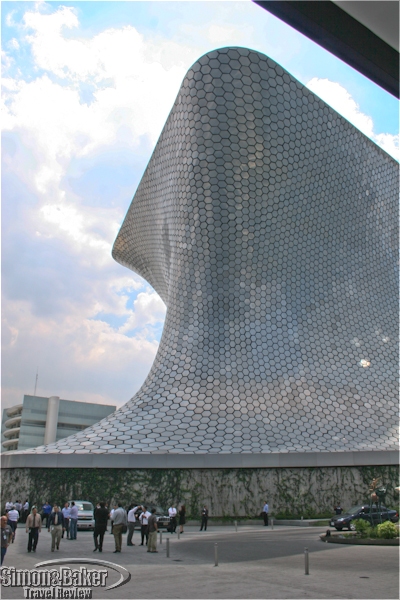
The unique exterior of the Soumaya Museum
During a recent trip to Mexico City, Mexico (see A weekend in Mexico City) I had an opportunity to visit the Museo Soumaya, one of the city’s fine arts museums and home of 400 Auguste Rodin and 60 Salvador Dali pieces among other fine arts works. The museum, named for a businessman’s deceased wife (said to have been an art lover and the inspiration for the collection), was the newer of two Soumaya museum buildings in the Mexican capital. Its 60,000 square feet of exhibit space housed ten percent (about six thousand items) of the extensive European and Mexican art collection of Mexican billionaire Carlos Slim Helu.
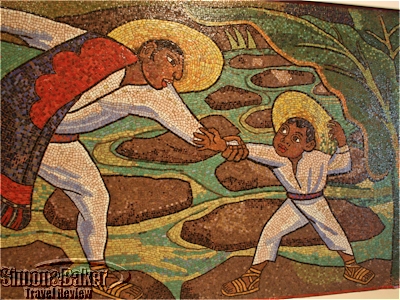
A section of a Diego Rivera Mural
Before entering the museum I was struck by the building’s exterior appearance, reminiscent to the Guggenheim Museum in Bilbao, Spain. Fernando Romero, Slim’s son in law, was the designer of the hourglass shaped building sandwiched between a mixed used building and shopping center and tall office towers. The light filled interior with a predominance of white was minimalistic and without windows.
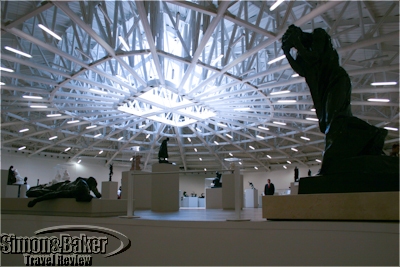
The interior features suffused natural light
Attracting a mainly domestic audience, 70 percent, thanks to ongoing free admission, the museum had had a million visitors in the 14 months since its inauguration. For many Latin Americans, someone later shared with me, the museum provided access to the works of famed European artists such as El Greco, Van Gogh, Matisse, Degas and Picasso that they might not otherwise be able to see without a journey overseas.
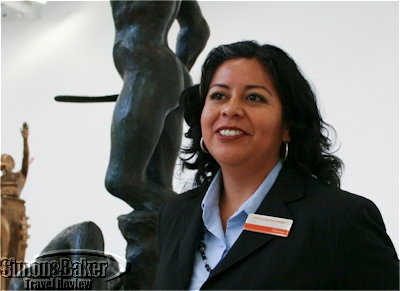
Guide Alsacia Lorena Herrera Ojeda
Alsacia Lorena Herrera Ojeda, our well informed English speaking guide, first showed us The Thinker and a two-sided Diego Rivera mural she explained was originally commissioned for a pool area, in the museum entrance level. The seventh of twenty-four The Thinker sculptures by the famous French artist occupied a prominent place in the sparsely populated floor. The Rivera faced the bathroom en route to the museum’s gift shop and restaurant.
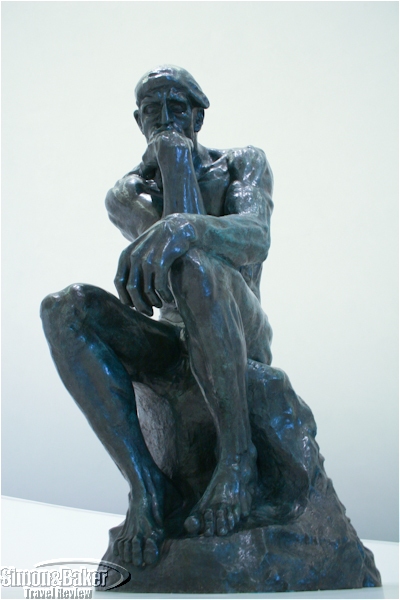
The Thinker
She then escorted us up a broad spiral staircase from the lobby to the top floor where we had a chance to view a number of Rodin and Dali sculptures. Rays of sunlight filtered down from the glass ceiling, illuminating the dozens of artworks on display. On the way down she stopped to shows us a few pieces and pointed to a handful of display walls with color. The museum was in the process of adding color to the exhibit space, she explained. The guided visit to the museum was a culturally rich way to spend tourist time in Mexico City. Museo Soumaya Fundacion Carlos Slim, Plaza Carso, Blvd. Miguel de Cervantes Saavedra 303 Col. Ampliación Granada, Miguel Hidalgo C.P.11529, México, D.F. , + 52 55 1103 9800, museosoumaya.org
by Editor | Nov 5, 2012 | Food and Wine
Article and photos by Elena del Valle
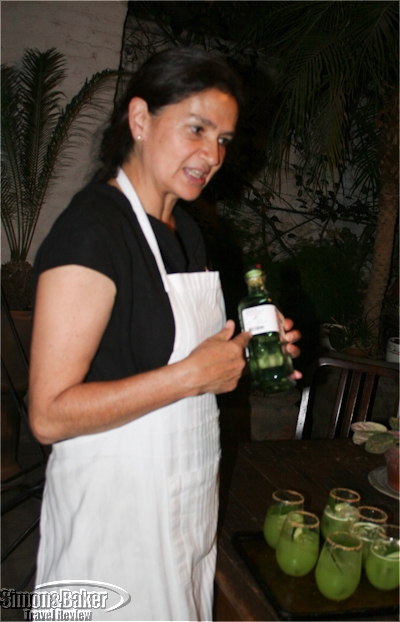
Before dinner Chef Monica Patiño described the evening’s artisan mezcals
On my first night in Mexico City, Mexico earlier this year I had a contemporary Mexican dinner with small production mezcals and Mexican wines at the French Porfirian style home of Chef Monica Patiño. The house is exceptional, someone from Mexico City explained before we arrived. Built in 1916 in La Roma it is part of a past era and situated in one of the city’s most upscale neighborhoods.
The Body and Soul Refreshment Menu served at 8:30 p.m. began with El 19 cocktails on the first floor of the multi-level house with an inner courtyard. The refreshing and lightly sweet homemade beverages were a blend of Mano Negra, an artisanal mezcal, celery, cucumber, epazote (a fragrant Mexican herb), lemon and brown sugar, served in a short glass rimmed with salt, chili and crushed maguey worms. Delicious.
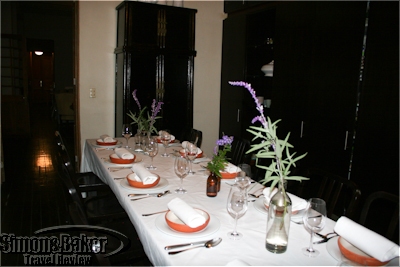
There were ten of us including the chef at the dinner table
Three hors d’oeuvres were served with the green tinted drinks. The first two were so hot (my tolerance for hot dishes is low) I only managed a single bite of each, Tostadas de Guacamole, guacamole served atop a nacho like cracker, and Tostada de Ceviche Verde, a crunchy corn cracker with citrus marinated seafood. My favorite was the Panuchos de Cochinita, a handheld appetizer of savory shredded pork without chili heat and a good match for the mild tasting cocktail.
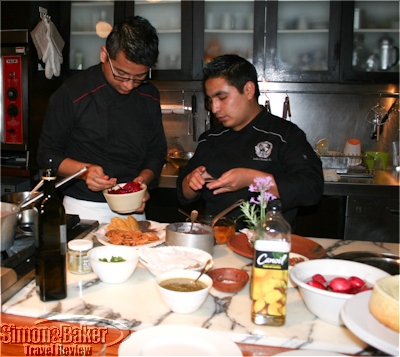
Ricardo Garcia, chef, Naos and Jesus, his assistant, in the kitchen
Prior to dinner, some of the members of our small group watched the staff prepared the pre-appetizers. Following cocktails, we were invited to an indoor dining room with a set table, past an open kitchen where the chef and her staff prepared the meal. Before sitting at the table with us, Chef Patiño, with the assistance of Ricardo Garcia, chef, Naos (owned by Chef Patiño) and Jesus, his assistant, prepared the meal. I especially appreciated her explanations about mezcal production and the preparation of the meal during the course of the evening.
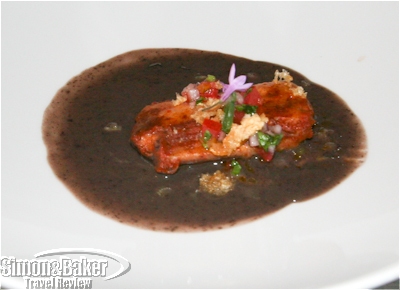
Tamalito Costeño en Caldillo de Frijol, our appetizer
For an appetizer the staff served Tamalito Costeño en Caldillo de Frijol, a tiny tamale in a black bean sauce made with corn, beans, chilies, raisins and almonds. The main course was an unusual interpretation of Pozole, a well known specialty Mexican dish. It was so unusual that several of the Mexicans in attendance were tasting the dish for the first time. A server brought each of us a bowl with Pozole Verde con Camarón, a green soup made from seeds, corn, tomato, serrano peppers, shrimp and clams. Then he brought a platter with sliced radish and sardines to us the table to add to the pozole. There was one red wine, Ensamble Colina 2008, and one white wine, Emblema 2008 sauvignon blanc, on offer with dinner. I sampled the red and found it somewhat syrupy for my taste.

Pozole Verde con Camarón, a green seafood soup
The dessert that night was my single favorite dessert during that Mexico City visit. Mixiote de Queso con Helado de Mezcal was a cheese filled filo pastry, with nougat, pumpkin seeds, atop a sauce of piloncillo (a raw sugar cane product), mezcal, and agave baked, fermented and distilled. The pastry itself was topped with mezcal ice cream which had powdered cinnamon crowning it. At the table, we were offered grated Parmesan cheese and sea salt to compliment the pastry and ice cream dish. My mouth waters at the memory. Mezcal Amores, family produced like the first one, was served with dessert.
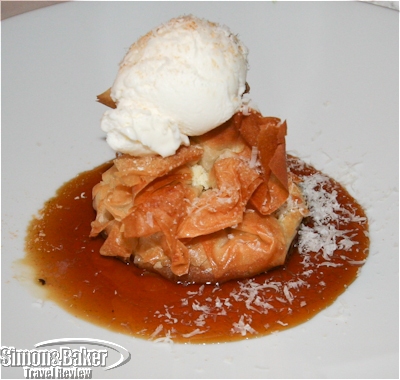
Mixiote de Queso con Helado de Mezcal, a cheese filled filo pastry
Dinner at the chef’s home was by special arrangement. Chef Patiño has more than 34 years of experience in the kitchen. She began her career with an internship at La Hacienda de los Morales before attending L’Ecole de Cuisine de la Varenne in Paris, France. In 1978, she opened La Taberna del Leon in Valle de Bravo, Mexico. Eleven years ago, she established another La Taberna del Leon in honor of her first restaurant. Bolivar 12, serving Mexican cuisine with a Cuban influence, and Naos followed. In 2007, she became a consultant for Aeromexico. In July of this year, she taped Everyday Cooking with Mónica Patiño, a cooking segment on Utilísima, a Fox program in Argentina. Monica Patiño Marquez, +55 52 0155 55 11 05 50, monica_patino@hotmail.com







































